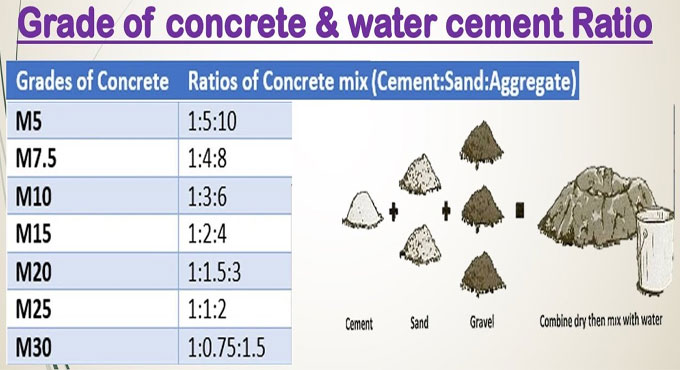
Details guidelines on Water Cement Ratio
Water cement ratio means the ratio among the water and cement by weight. The quantity of water added to the cement at the time of developing concrete mixes, significantly affect the quality of concrete. As per Abraham?s theory, the strength of Concrete / Mortar is influenced by the net quantity of water applied for each sack of cement. Water also impacts the entire properties, the stability as well as strength of concrete considerably.
So, proper care should be taken to utilize the amount of water in the mix.
If there is surplus water, the workability of concrete will be raised, but the strength and longevity of concrete will be significantly damaged. If the quantity of water is less, the strength and durability of concrete will be raised but its workability will be reduced. For this reason, the quantity of water should be chosen properly before using it in the mix.
Functions of Water in Concrete - Usually, the water executes the following functions in concrete:
1. It hydrates the cement, that is an important chemical reaction for developing complex silicate crystalline gels vulnerable for the strength of the cement.
2. It lubricates all the concrete materials, by circulating them in the form of films. Consequently, it is accountable for the plasticity and mobility of concrete which entitle its workability.
Workability of Concrete: The workability is a crucial characteristic of concrete it its stage. Workability means the easiness with which the concrete is mixed, conveyed, placed and consolidated. It is also described as the account of work essential to set concrete and to consolidate it comprehensively.
The workability is related with the following four factors :-
1. Easiness of flow (internal friction)
2. Prevention of segregation
3. Prevention of harshness
4. Prevention of bleeding
Workability of concrete is primarily based on the quantity of water contained in it.
Process for Water Cement Ratio Calculation :-
According to various theoretical studies and experimental investigations for ordinary Portland Cement, it is found that 1 part of cement (by weight) needs approx 0.25 parts of water (by weight) for total hydration, setting, and solidifying of concrete/mortar.
Normally, at the time of forming a concrete mix, this quantity of water is suitable only for hydration. For lubrication and workability of the mix, extra water is required.
This extra quantity is need when the water differs from 0.15 to 0.45 parts by weight and should be ascertained perfectly. This extra (lubricating) water is vaporized as soon as the concrete is set. Water is also discharged throughout compaction.
Impact of extra water on Concrete-Mix :-
Both of the methods mentioned above (of the escape of additional water) lead to voids in the concrete and as a result, the strength of concrete is reduced. So, it is suggested to retain water cement ratio as low as possible to produce a strong, solid concrete-mix. When any additional amount of water is included to concrete materials at the time of mixing, it leads to segregation of aggregates throughout the transport and placement.
Water Quantity Calculation for Concrete.
For the measurement of water quantity for concrete, initially, it is required to determine the quantity of cement.
Suppose, the necessary volume of cement for the mix is 100 kg and W/C is 0.4.
Water Quantity = Water-Cement Ratio x Volume of Cement.
Water Quantity = 0.4 x 100 kg = 40 liters / 100 kg cement or (20 liters / 50 kg cement bag).
Test to measure Water-Cement Ratio
It is important to test the calculated W/C practically.
To determine the workability and consistency of the mix, concrete slump test (www.quantity-takeoff.com) should be conducted.


